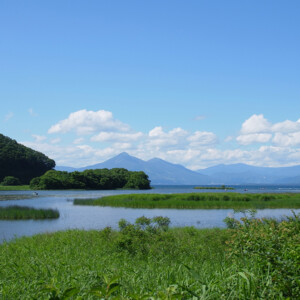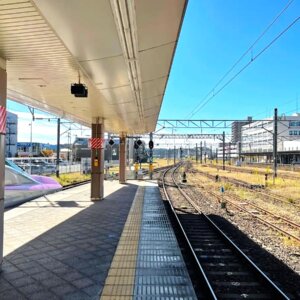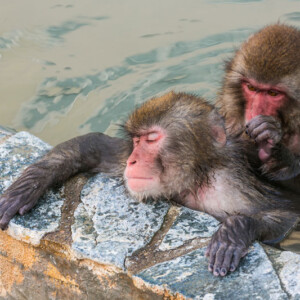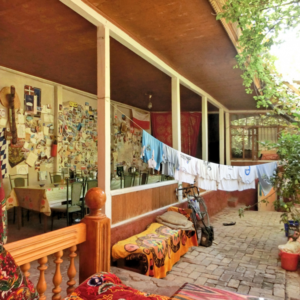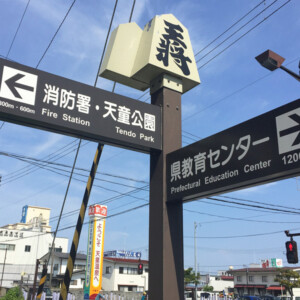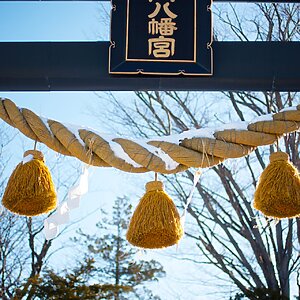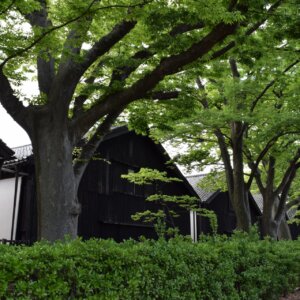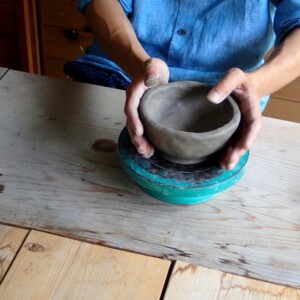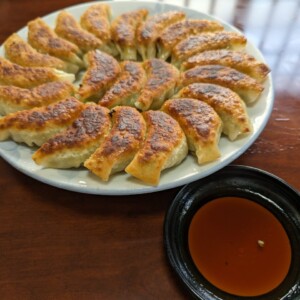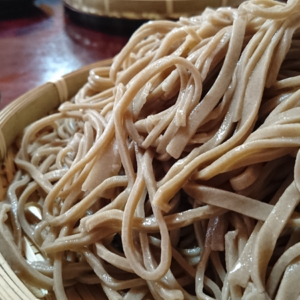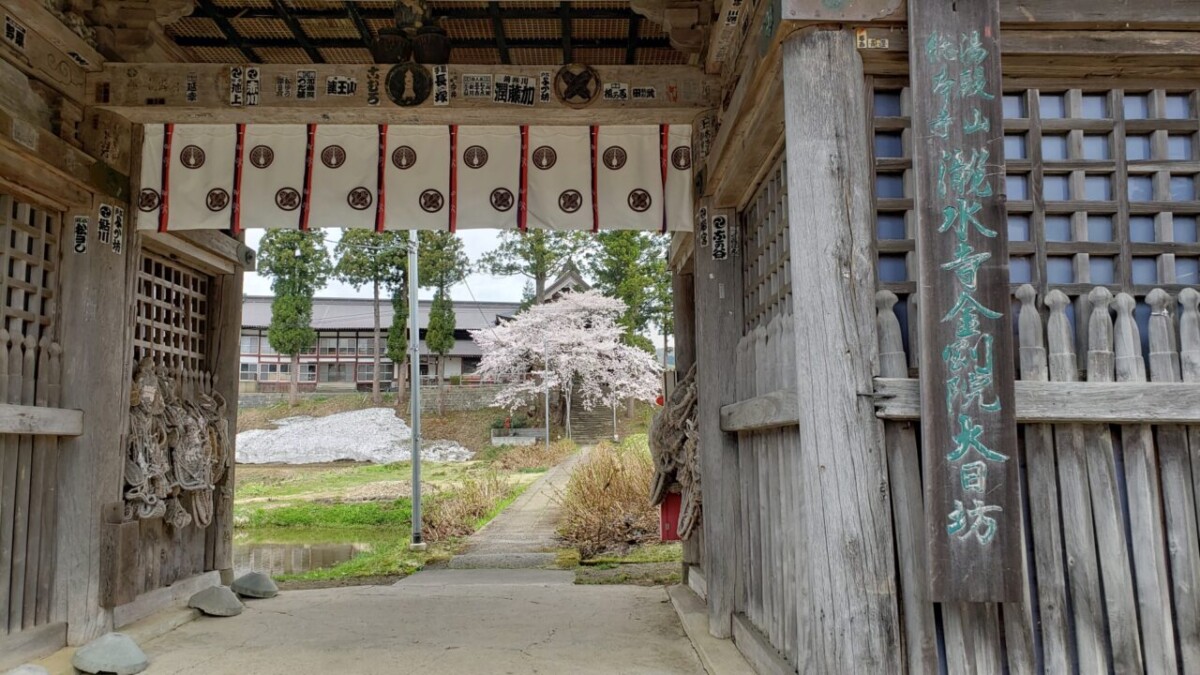
Rokujurikoshi Kaido, which passes through the foot of Mt. Yudono, is a road to visit the Dewa Sanzan.
table of contents
- 1 The Rokujurikoshi Highway was sometimes used as a military road.
- 2 The Dewa Sanzan pilgrimage was visited by many common people from Edo.
- 3 Villages along the highway were devastated during the Boshin War, and the Dewa Sanzan pilgrimage declined.
- 4 Many ruins remain along the forgotten old road.
- 5 Shrines and temples from the heyday that still remain along the Rokjurikoshi Highway
- 5.1 “Hondojiguchinomiya Yudonoyama Shrine” is one of the four temples of Mt. Yudono and is now a shrine.
- 5.2 Hondojiguchinomiya Yudonoyama Shrine <Information>
- 5.3 The head temple of the four temples on Mt. Yudono, the main temple of Mt. Yudono, Takisui-dera Dainichibo Temple
- 5.4 Takimizudera Dainichibo <Information>
- 5.5 Currently, Yudonoyama Shurenji is the main temple of Mt. Yudono.
- 5.6 Shurenji Temple<Information>
- 6 Tamumata village flourished as a post station for pilgrims to the Dewa Sanzan pilgrimage.
``Rokujyuri Goe Kaido'' is a road on the Ushu Kaido that runs from Yamagata to Tsuruoka, passing over several passes at the foot of the three Dewa Sanzan mountains. It is said that this is why it came to be called ``Rokujyurigoe Kaido.''

It is not well known when the term ``Rokujurikoshi Kaido'' began to be used, but Mt. Haguro, one of the three Dewa mountains, was founded in 593. It was founded by Kobo Daishi in 807, so it seems to have been in use around that time.
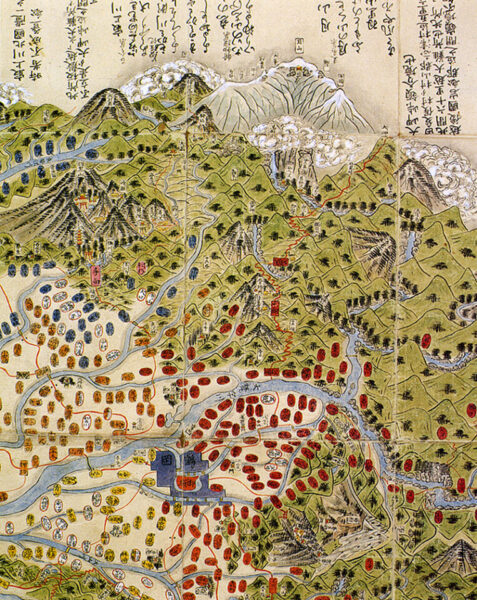
The Rokujurikoshi Highway was sometimes used as a military road.
Around the Asuka period, the Tohoku region was known as Emishi, and there remained many areas beyond the reach of the Yamato court. Therefore, the imperial court sent troops to increase the area under its control. The road that was used at that time was the ``Rokujurikoshi Highway,'' which apparently played a major role as a military road.
From the late Heian period to the Muromachi period, when Ezo came under the control of the Yamato court, it served as a path of worship for practitioners of the Dewa Sanzan faith, and further down the road, during the Sengoku period, when feudal lords divided their territory in various areas. It was once again the path of war.
In the Edo period, the ``Rokujurikoshi Kaido'' came to be used by the Shonai domain (Tsuruoka City) and Akita domain as a road for sankin kotai, and also played an important role as a trade route connecting the Shonai region and the Mogami Murakami region. I did.
The Dewa Sanzan pilgrimage was visited by many common people from Edo.
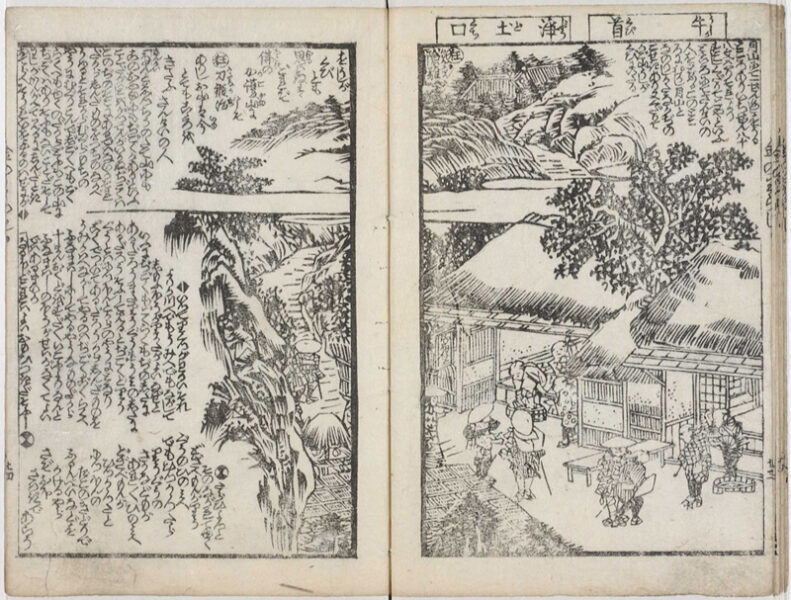
During the long period of peace, the Dewa Sanzan pilgrimage became popular along with the Ise pilgrimage, and many common people from Edo came to visit the area. Inn stations were established in villages such as Matsune, Oami, Tamumata, Shizu, Hondoji, and Shiraiwa at the foot of Mt. Yudono, and they were very crowded.
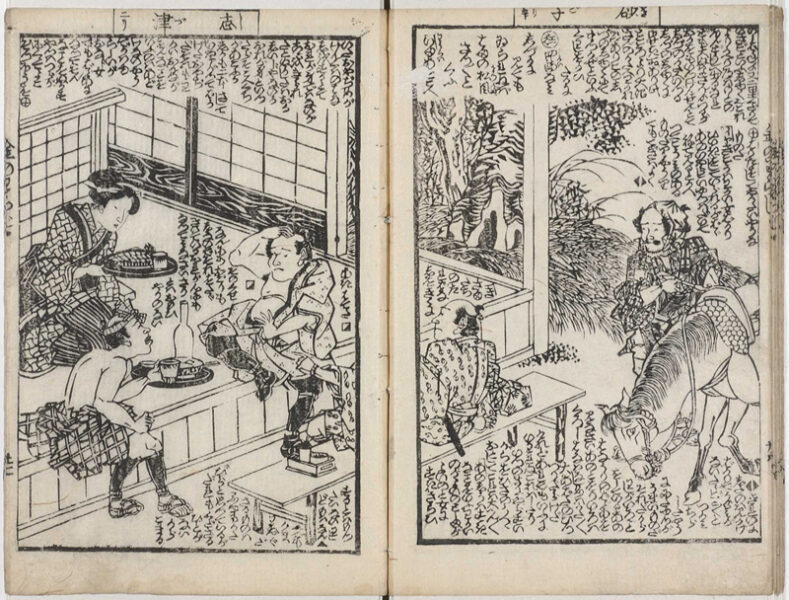
Its appearance is described in a passage from the book ``Kane no Waraji'' by playwright Ikku Juppensha (whose masterpiece ``Tokaido Chuuhizakurige'') was published in 1801. After going four li, there is Mt. Yudono on the right, and after passing a place called Sasagoya, there is a rice lodge.It is all around this area, from Hondoji to the foot of Yudono, and from Oami to Hondoji, 60 ri. After passing through Tamamumata, there is a large temple called Dainichibo, which is the mountainside of the hot springs.There is a checkpoint in Oami, which is about a mile and a half from here.The travelers who cross Oami and stay overnight are probably migratory birds of mountain hikers. The text reads, ``Go past Matsune and you'll reach the castle town of Tsurugagaoka'', with illustrations depicting the bustle of the highways and inns.
Villages along the highway were devastated during the Boshin War, and the Dewa Sanzan pilgrimage declined.
In 1868, when the Edo period turned into the Meiji period, the Boshin War broke out, a fierce battle between the new Meiji government army and the old Shogunate army trying to protect the Edo shogunate. The Shonai clan, together with the Aizu army in Fukushima, fought against the new government army as part of the former shogunate army. The ``Rokujurikoshi Kaido'' was used as a marching road for government troops, and a fierce battle took place with the attacking Shonai clan army. Villages along the highway suffered devastating damage, and after the end of the war, the Meiji government issued an order to separate Shinto and Buddhism, and the Dewa Sanzan pilgrimage was completely abolished.
In 1899 (Meiji 32), a new road was constructed on the Rokujurikoshi Kaido, which was a mountainous road that was inconvenient for cars. After that, it was renovated several times, and finally became National Route 112 in 1953 (Showa 28). As a result, the infrastructure from Yamagata City and Sagae City to Tsuruoka City has become very convenient, and Dewa Sanzan can now be reached by car or bus. On the other hand, the old road, ``Rokujurikoshi Kaido,'' has become a forgotten road with almost no people walking on it.
Many ruins remain along the forgotten old road.
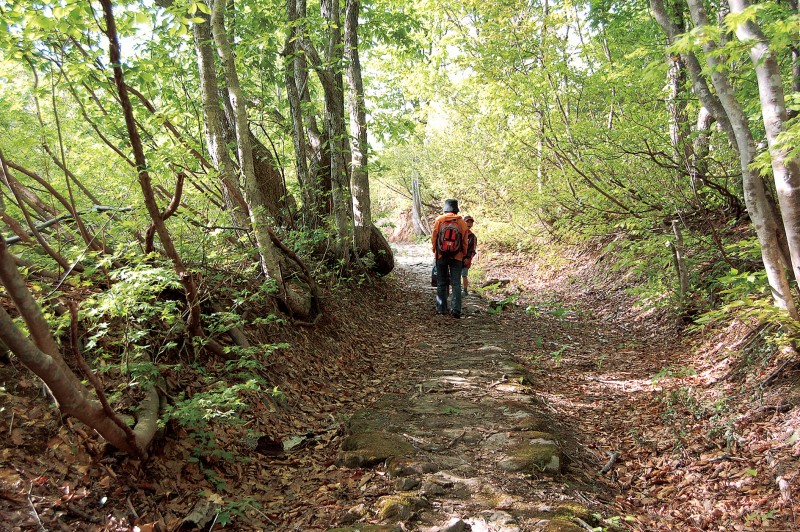
The old road at the foot of Mt. Yudono, off National Route 112, has been left behind by development, and many old ruins remain. There are also ancient temples and shrines that are deeply connected to Mt. Yudono, and now it is once again attracting attention as the ``Rokujyurigoe Highway''. Roads that were once difficult to pass have been repaired, and many people now visit the area as a hiking and trekking course.
The ``Rokujurikoshi Kaido'' is approximately 30km along the foot of Mt. Yudono. It will take at least three days to walk the entire course at once. For this reason, we have set up day-trip courses divided into several sections, and you can also ask a guide to guide you.
The route set in Nishikawa-cho, located in the eastern part of "Rokujurikoshi Kaido", is
■Ippongizawa - Shizuguchi Station Ruins - Ishibukigawa Bridge Approximately 6.8 km / Required time... Approximately 5 hours ~
■Ishibukigawa Bridge - Doshinbozaka - Yakeyama Ridge - Oshima Pass - Yudonoyama Hotel Ruins Approximately 6.6 km / Required time... Approximately 5 hours ~
■Yudonoyama Hotel Ruins ~ Sasagoya Ruins ~ Hosogoshi Pass ~ Kobo Chaya ~ Arikoshizaka Approximately 6.6 km / Required time... Approximately 5 hours ~
■Tamumata Arikosaka - Yanagi Shimizu - Sai no Kami Pass - Inari Pass - Shirenji Temple Approximately 6.6 km / Required time... Approximately 5 hours ~
■Shurenji Temple ~ Otakiyama Oiwake Stone ~ Koshin Tower ~ Hachiman Shrine in Matsune Approximately 6.4 km / Required time... Approximately 5 hours ~
(Implementation period: June to November Guide fee: 15,000 yen per day)
Additionally, the Tsuruoka City Asahimura Tourism Association, located in the western area, introduces several short courses.
*Rokujurikoshi Kaido is a mountain road, so there may be sections where traffic is closed due to weather etc. Please always contact Nishikawa Town (0237-74-84-0566), Asahimura Tourism Association (0235-53-3411), etc. for the latest information.

Shrines and temples from the heyday that still remain along the Rokjurikoshi Highway
There are important temples and shrines related to the Dewa Sanzan along the Rokujurikoshi Kaido. Let me introduce some of them.
“Hondojiguchinomiya Yudonoyama Shrine” is one of the four temples of Mt. Yudono and is now a shrine.
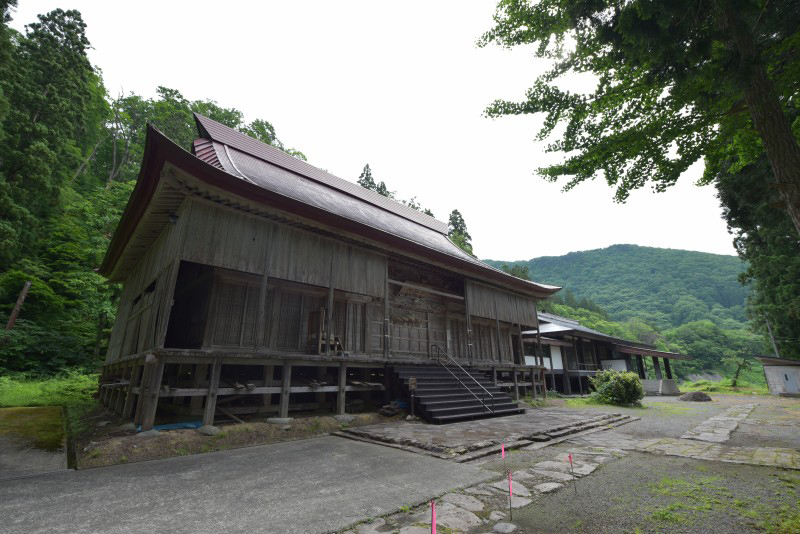
``Hondoji Kuchinomiya Yudono Sanjinja'' is the ``Gekkozan Hondoji Temple'' founded by Kobo Daishi in 809, which was converted to ``Yudonoyama Shrine'' due to the Meiji era's Separation of Shinto and Buddhism ordinance. This is what I did. Hondo-ji Temple is one of the four temples of Mt. Yudono founded by Kobo Daishi on Mt. Yudono, and was also used as a place of prayer for the Tokugawa shogunate during the Edo period.
The shrine building was rebuilt after being burnt down during the Boshin War, and it became a hot topic because the Buddhist statues from the temple era, which had been scattered during the separation of Shinto and Buddhism, were returned for the first time in 130 years.
Hondojiguchinomiya Yudonoyama Shrine <Information>
- Name: Hondojiguchinomiya Yudonosan Shrine
- Location: 381 Daikokumori, Hondoji, Nishikawa-machi, Yamagata Prefecture
- Phone number: 0237-74-3565
- Visiting hours: 9:30-16:30
- Admission fee: 300 yen
- access:
- Railway/About 25 minutes by taxi from JR Sazawa Line Sazawa Station
- Car: Approximately 7 minutes on National Route 112 from Yamagata Expressway Nishikawa IC
- URL: Hondojiguchinomiya Yudonoyama Shrine
Google Map
The head temple of the four temples on Mt. Yudono, the main temple of Mt. Yudono, Takisui-dera Dainichibo Temple
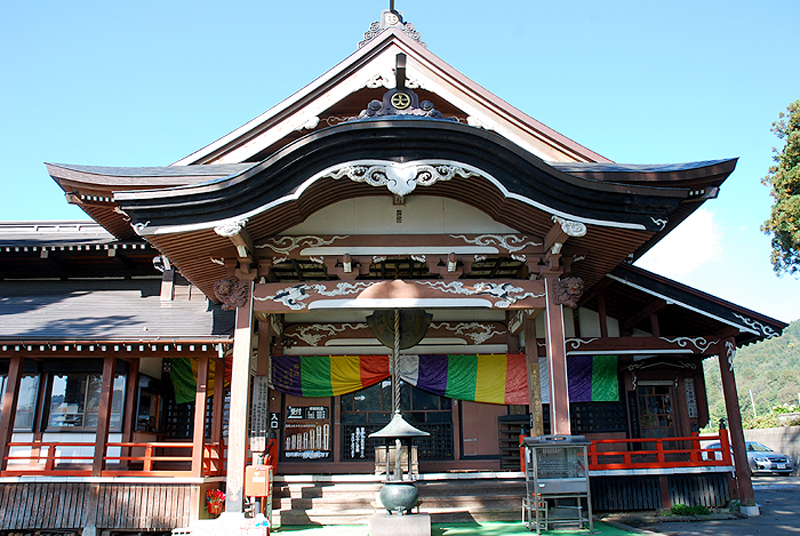
Ryusuiji Dainichibo, the main temple of Mt. Yudono, is the head temple of the four temples of Mt. Yudono, which was founded by Kobo Daishi in 807. It was built as a temple where women could visit since Mt. Yudono was a mountain where women were not allowed. When Shinto and Buddhism were separated, it remained as a temple, with the principal image created by Kobo Daishi himself, the Sokushinbutsu ``Shinnyokai Shonin'', and the nationally designated Important Cultural Property ``Kondobutsu Shaka Nyorai Standing Statue''. )” and other cultural properties are protected.
Takimizudera Dainichibo <Information>
- Name: Yudonosan Sohonji Temple Takisui-dera Dainichibo Temple
- Location: 11 Oamiza Nyudo, Tsuruoka City, Yamagata Prefecture
- Phone number: 0235-54-6301
- Visiting hours: 8:00-17:00 (Reception until 16:30)
- Admission fee: Adults 500 yen, Junior high school students 400 yen, Elementary school students 300 yen
- access:
- Railway: Approximately 45 minutes by bus bound for Yudonoyama from Tsuruoka Station on the JR Uetsu Main Line, then approximately 20 minutes' walk from Oami bus stop.
- Car: Approximately 30 minutes on National Route 112 from Yamagata Expressway Gassan IC
- URL: Yudonosan Sohonji Temple Takisuidera Dainichibo Temple
Google Map
Currently, Yudonoyama Shurenji is the main temple of Mt. Yudono.
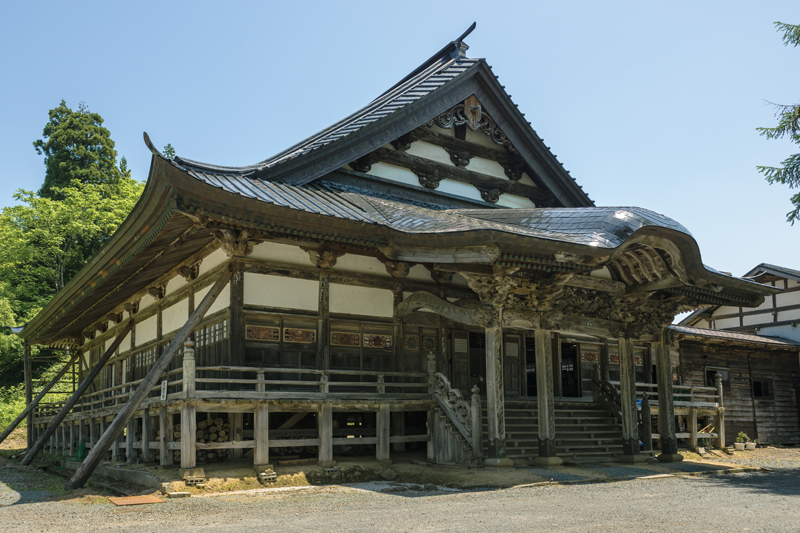
Yudono-san Shuren-ji Temple is one of the four temples of Yudono-san Temple founded by Kobo Daishi in 825, and flourished as a shrine for women at the front entrance of Mt. I have mastered it. After the separation of Shinto and Buddhism, the temple temporarily declined, but since then it has once again become the central temple of Mt. Yudono and is visited by many worshipers. It is also known for enshrining the Sokushinbutsu of Tetsumon Kaishonin.
Shurenji Temple<Information>
- Name: Yudonoyama Shurenji Temple
- Location: 92-1 Oamiza Nakadai, Tsuruoka City, Yamagata Prefecture
- Phone number: 0235-54-6536
- Visiting hours:
- May-October/9:00-17:00
- November - April / 10:00 - 16:00
- Open all year round
- Admission fee: 500 yen for adults, 300 yen for children
- URL: Mt.Yudono Shurenji Temple
Google Map
Tamumata village flourished as a post station for pilgrims to the Dewa Sanzan pilgrimage.
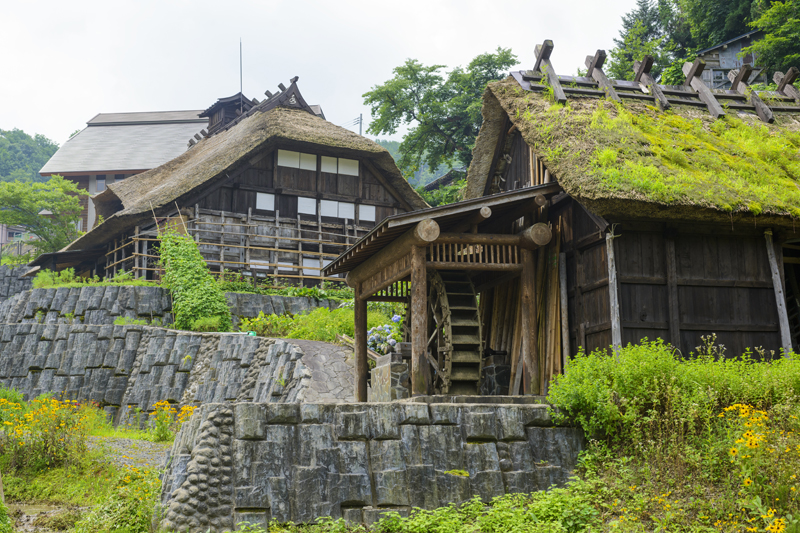
Tamugimata is one of the post stations on the Rokujurikoshi Kaido. During the Edo period, many tourists visited Mt. Yudono. However, after the Meiji period, fewer people visited this mountain village, and it became completely deserted.
Meanwhile, in Tsuruoka during the Meiji period, production of silk fabrics later known as "Samurai Silk" began. However, in Tsuruoka, the breeding of silkworms (sericulture), which is the raw material for silk thread, was not carried out, so the people of Tamumata turned to sericulture to make a living. As a result, he renovated his home for sericulture and built a very unusual tall building with a thatched roof, 4 layers and 3 stories.
The former Shibuya family residence, which remains almost completely intact, has been relocated and preserved at the Chido Museum in Tsuruoka City as a nationally important cultural property.
Tamumata<Information>
- Name: Tamumata
- Location: Tamumata, Tsuruoka City, Yamagata Prefecture
- Phone number: 0235-53-2111 (Tsuruoka City Hall Asahi Building)
- Railway: Approximately 1 hour and 20 minutes by bus bound for Tamumata from Tsuruoka Station on the JR Uetsu Main Line (2 buses per day)
- Car: Approximately 2.5km from Yamagata Expressway Yudonoyama IC
Google Map
Related information
- Dewa's ancient road Rokujurikoshi Kaido (Tsuruoka City Asahi Village Tourism Association)
- Phone number: 0235-53-3411
- URL: Tsuruoka City Asahi Village Tourism Association
- Wandering Nishikawa Guide Rokujurikoshi Kaido (Nishikawa Town Gassan Asahi Tourist Information)
- Phone number: 0237-74-0566 (Nishikawa Town Commerce and Tourism Division)
- URL: Nishikawa Town Gassan Asahi Tourist Information
- Scenic road in the Tohoku region, Dewa's ancient road, Rokujurikoshi Kaido (Ministry of Land, Infrastructure, Transport and Tourism, Tohoku Regional Development Bureau)
- URL: Scenic road in the Tohoku region, Dewa's ancient road, Rokujurikoshi Kaido



![Scary and slightly sad stories... "Michinoku Otogi Kaido" with many stories left behind [Shichigasyu-cho, Shiraishi City, Miyagi Prefecture] Fairytale images](https://jp.neft.asia/wp-content/uploads/2023/04/be73b392233d2fe609797e999f8ca547-1-150x150.jpg)
![[Kamiyama City, Yamagata Prefecture] “Narageshuku” is a post town on the Ushu Kaido road that was used by 13 feudal lords during the Edo period. Narageshuku](https://jp.neft.asia/wp-content/uploads/2023/06/f78e23352609b6986737197999be71c6-150x150.webp)
![[Fukushima Prefecture] Is Kuwaori Town, the northern town, the birthplace of the Date family? 1401-009](https://jp.neft.asia/wp-content/uploads/2022/12/1401-009-150x150.jpg)
![[Yamagata Prefecture] Tsuruoka's silk fabric industry created by changing swords to hoes. 5182039_m](https://jp.neft.asia/wp-content/uploads/2023/02/5182039_m-150x150.jpg)
![[Misato Town, Akita Prefecture] ``Rokugo Yusui Group'' where 120 springs have enriched people's lives 24946543_m](https://jp.neft.asia/wp-content/uploads/2023/02/24946543_m-150x150.jpg)
![The specialty of Genbikei, "Flying Dango," is definitely worth a visit! Delicious activities! [Ichinoseki City, Iwate Prefecture] Genbikei bus stop](https://jp.neft.asia/wp-content/uploads/2017/04/IMG_5931-150x150.jpg)
![Oyu ring stones are stone circles from the Jomon period of Japan! ? [Akita Prefecture] afa86939a1f3e49c2a7ae110b4ddb2b4_m](https://jp.neft.asia/wp-content/uploads/2017/08/afa86939a1f3e49c2a7ae110b4ddb2b4_m-150x150.png)
![The "Devil's House" is a demon museum where demons from all over the world gather! [Kitakami City, Iwate Prefecture] demon of the world](https://jp.neft.asia/wp-content/uploads/2018/09/PXL_20240218_035145749-150x150.jpg)

